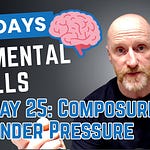Have you ever been so completely absorbed in something that time seemed to slow down, speed up, or even stand still? You were playing a musical instrument, solving a complex problem, or engaged in a physically demanding activity and you then realised hours had passed in minutes. This is the experience of flow—what researchers call the pinnacle of human performance and the psychology of optimal experience (Csikszentmihalyi, 1990)1. At the heart of every flow state lies one critical mental skill: present moment awareness.
Present moment awareness involves paying attention to current experience with an attitude of openness and acceptance (Bishop et al., 20042). Rather than being lost in thoughts about past regrets or concerns for the future, present moment awareness anchors your attention in the here and now. This isn't merely concentration—it's a broader, more flexible awareness that includes thoughts, emotions, bodily sensations, and environmental cues without judgement or resistance.
As defined by one of the leading mindfulness researchers, Jon Kabat-Zinn (1994)3, it means "paying attention in a particular way: on purpose, in the present moment, and non-judgementally" (p. 4). This quality of attention creates the psychological foundation necessary for optimal experience to emerge.
Mental Skills Basics Course (Free)
The Gateway to Flow
Present moment awareness serves as the gateway to flow states because it directly enables several critical conditions that research has identified as necessary for optimal experience. When Csikszentmihalyi (1990) first identified the nine characteristics of flow, he discovered that each depends fundamentally on the ability to maintain present-focused attention.
Complete Concentration and Action-Awareness Merging
Flow requires what researchers call "complete one-pointedness of mind", where focus becomes laser-like and mental energy is entirely devoted to the task at hand (Nakamura & Csikszentmihalyi, 20144). Present moment awareness creates this concentrated attention by training your mind to resist the pull of distracting thoughts and irrelevant concerns. When you're truly present, there's no mental space for worrying about other obligations or ruminating on past mistakes—all cognitive resources become available for task execution.
Loss of Self-Consciousness
One of the most remarkable aspects of flow is the temporary disappearance of the internal critic that typically monitors and evaluates performance. Present moment awareness facilitates this by reducing what psychologists call "cognitive fusion"—the tendency to become entangled with your thoughts and treat them as absolute truths (Hayes et al., 2006)5. When you cultivate non-judgmental awareness, you learn to observe self-critical thoughts without being controlled by them, freeing up mental energy for optimal performance.
Enhanced Feedback Processing
Flow states require immediate and continuous feedback to maintain optimal challenge-skill balance. Present moment awareness enhances your sensitivity to environmental cues and bodily sensations that provide this crucial information (Brown & Ryan, 2003)6. Athletes in flow, for example, report heightened awareness of their body position, breathing, and the subtle changes in their performance environment. This enhanced sensitivity allows for real-time adjustments that keep you in the optimal zone.
The Liberation from Linear Time
Perhaps the most fascinating aspect of flow states is what Csikszentmihalyi (1990) identified as the "transformation of time", where hours feel like minutes or seconds stretch into eternity depending on the activity's demands. This temporal distortion reveals a profound truth about the nature of psychological time that has critical implications for achieving peak performance.
Our conventional understanding of time as a linear, uniform progression is a social construction rather than an inherent property of reality. Clock time—with its rigid schedules, deadlines, and temporal anxiety—represents an artificial framework that we've imposed on experience. This becomes starkly apparent during flow states, when the usual temporal structure that organises daily life dissolves (Csikszentmihalyi & LeFevre, 1989)7.
Research into the neuroscience of flow reveals that this temporal liberation occurs because the dorsolateral prefrontal cortex, which handles temporal awareness and cognitive control, shows decreased activation during optimal experiences (Dietrich, 2004)8. Simultaneously, the brain regions responsible for present-moment processing become more active, creating what researchers call "transient hypofrontality"—a temporary downregulation of the brain systems that make our sense of linear time.
To truly access flow states consistently, we must release our attachment to linear time concepts and embrace what might be called "experiential time"—the natural rhythm of engagement where duration is determined by the depth and quality of attention rather than clock measurements. This doesn't mean ignoring practical time considerations, but rather recognising that peak performance emerges when we prioritise present-moment engagement over temporal anxiety. When you stop watching the clock and start experiencing the moment, you create the psychological conditions where time can bend to serve your optimal experience rather than constraining it.
The Neuroscience Connection
Recent neuroscientific research reveals why present-moment awareness is so crucial for flow. Brain imaging studies show that flow states involve decreased activity in the prefrontal cortex—the brain region responsible for self-criticism and cognitive control—while increasing activation in areas associated with focused attention and reward processing (de Manzano et al., 2010). This pattern, called "transient hypofrontality," allows for the effortless performance characteristic of flow.
Mindfulness training directly supports this neural pattern. Research demonstrates that regular mindfulness practice strengthens the anterior cingulate cortex, which monitors attention and resolves conflicts between competing stimuli, while reducing activity in the default mode network associated with self-referential thinking (Katahira et al., 2018)9. This creates the ideal brain state for flow to emerge.
Practical Benefits for Peak Performance
Stress Reduction and Optimal Arousal
Present moment awareness facilitates a shift away from anxiety-producing thoughts about future outcomes or past failures, reducing rumination and worry (Jain et al., 2007)10. This stress reduction is crucial because flow requires a delicate balance between challenge and skill—too much anxiety pushes you out of the optimal zone into overwhelm. At the same time, too little arousal leads to boredom.
Enhanced Attention Control
Mindfulness training improves attentional control and sustained focus on specific tasks, as individuals learn to direct their attention intentionally (Jha et al., 2007)11. This enhanced attention control allows you to maintain focus even in challenging or distracting environments, a key requirement for accessing flow states consistently.
Cognitive Flexibility
The practice of present moment awareness fosters cognitive flexibility, allowing you to adopt alternative perspectives and interpretations of challenging situations (Chambers et al., 2009)12. This flexibility prevents you from becoming stuck in rigid thinking patterns that can disrupt flow, enabling more adaptive problem-solving during optimal performance.
Self-Compassion and Resilience
The non-judgmental attitude cultivated through present moment awareness promotes self-compassion, which supports overall confidence and self-acceptance (Shapiro et al., 201213). This self-compassion creates the psychological safety necessary to take the risks and embrace challenges that flow states require.
Cultivating Present Moment Awareness for Flow
Research by Moore (2013)14 demonstrates that mindfulness meditation enhances athletes' ability to access flow states by improving present-moment awareness and reducing self-focused attention. Simple daily practices such as breath awareness, body scanning, and mindful walking create the attentional stability necessary for optimal experience.
The key is developing what researchers call "attentional training" through mindfulness practice and concentration exercises (Nakamura & Csikszentmihalyi, 2014). These practices build the capacity for sustained focus that flow requires while teaching you to observe thoughts and emotions without being controlled by them. Equally important is learning to let go of clock-time consciousness during performance—allowing yourself to be guided by the natural rhythm of engagement rather than artificial temporal constraints.
Conclusion
Present moment awareness isn't just helpful for flow—it's essential. Every characteristic of optimal experience, from complete concentration to loss of self-consciousness to the transformation of time, depends on your ability to anchor attention in the present moment with acceptance and openness. By developing this fundamental skill through mindfulness practice and releasing attachment to linear time concepts, you create the psychological conditions necessary for flow to emerge naturally and frequently. In a world filled with distractions and performance pressure, present-moment awareness offers a reliable pathway to the transcendent experiences that represent the pinnacle of human potential.
Mental Skills Basics Course
Suffering stress and anxiety is not a prerequisite for success in self-employment–there's a better way. Mental skills provide you with the means of coping effectively with difficulty and achieving your goals. I created the Mental Skills Basics Course to introduce business leaders, self-employed individuals, freelancers, consultants, and small business owners to the psychological and emotional skills associated with success.
References
Csikszentmihalyi, M. (1990). Flow: The psychology of optimal experience. Harper & Row.
Bishop, S. R., Lau, M., Shapiro, S., Carlson, L., Anderson, N. D., Carmody, J., ... & Devins, G. (2004). Mindfulness: A proposed operational definition. Clinical Psychology: Science and Practice, 11(3), 230-241
Kabat-Zinn, J. (1994). Wherever you go, there you are: Mindfulness meditation in everyday life. Hyperion.
Nakamura, J., & Csikszentmihalyi, M. (2014). The concept of flow. In Flow and the foundations of positive psychology (pp. 239-263). Springer.
Hayes, S. C., Luoma, J. B., Bond, F. W., Masuda, A., & Lillis, J. (2006). Acceptance and commitment therapy: Model, processes and outcomes. Behaviour Research and Therapy, 44(1), 1-25.
Brown, K. W., & Ryan, R. M. (2003). The benefits of being present: Mindfulness and its role in psychological well-being. Journal of Personality and Social Psychology, 84(4), 822-848.
Csikszentmihalyi, M., & LeFevre, J. (1989). Optimal experience in work and leisure. Journal of Personality and Social Psychology, 56(5), 815-822.
Dietrich, A. (2004). Neurocognitive mechanisms underlying the experience of flow. Consciousness and Cognition, 13(4), 746-761.
Katahira, K., Yamazaki, Y., Yamaoka, C., Ozaki, H., Nakagawa, S., & Nagata, N. (2018). EEG correlates of the flow state: A combination of increased frontal theta and moderate frontocentral alpha rhythm in the mental arithmetic task. Frontiers in Psychology, 9, 300.
Jain, S., Shapiro, S. L., Swanick, S., Roesch, S. C., Mills, P. J., Bell, I., & Schwartz, G. E. (2007). A randomized controlled trial of mindfulness meditation versus relaxation training: Effects on distress, positive states of mind, rumination, and distraction. Annals of Behavioral Medicine, 33(1), 11-21.
Jha, A. P., Krompinger, J., & Baime, M. J. (2007). Mindfulness training modifies subsystems of attention. Cognitive, Affective, & Behavioral Neuroscience, 7(2), 109-119.
Chambers, R., Gullone, E., & Allen, N. B. (2009). Mindful emotion regulation: An integrative review. Clinical Psychology Review, 29(6), 560-572.
Shapiro, S. L., Carlson, L. E., Astin, J. A., & Freedman, B. (2012). Mechanisms of mindfulness. Journal of Clinical Psychology, 62(3), 373-386.
Moore, Z. E. (2013). Mindfulness-Acceptance-Commitment (MAC) based performance enhancement for university athletes: A preliminary investigation. The Sport Psychologist, 27(4), 339-351.









